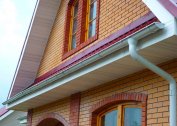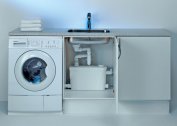Owners of country houses and cottages often have the problem of disposing of household waste, provided that there is no connection to a centralized sewer line. Equipping your land, unfortunately, it’s not enough just to dig a pit and install a septic tank there. It is necessary to think in more detail how to organize high-quality and unhindered wastewater disposal.
Types and characteristics of hoses
Hoses are designed to connect the connecting elements. The main characteristic of the product is the thickness of the material used in its production. The thickness is divided into internal and external, and the wall thickness is also considered separately.
When installing the equipment, the external diameter is taken into account, it is this indicator that allows you to determine the number of necessary fasteners and the required hose length. Wall thickness affects the flexibility and strength of the material. The inner diameter determines the quality and quantity of fluid, pressure.
Also for pumping stations, two types of pipes are formed:
- fences
- watering.
Intake, it is also a suction element for a drainage pump is characterized by such technical parameters:
- The operating temperature of the pumped liquid ranges from -10 to +50 degrees.
- The surface is reinforced to enhance strength.
- Permissible load is 6 bar.
- Made of rubber or metal.
- The equipment has a variety of equipment, for example, in addition, the pipe can be equipped with water filters and check valves.
There is no need to buy durable irrigation pipes because they do not face heavy loads. Subject to all operating rules, the average hose service life is 10 years.
Reinforced equipment is made using polyester yarn. This heavy-duty material has a long service life and is also characterized by high wear resistance. Such tubes can withstand even very high pressure.
Technical characteristics of reinforced hoses:
- Operating pressure ranges from 25-8 atmospheres.
- The inner diameter can be from 7 to 32 mm.
- Bending radius within 10-40 cm.
- The wall thickness is 2.5-4.5 mm.
Corrugated products are a type of reinforced pipe, but in this case, spiral technology is used. Each turn is a separate segment. This option is not practical, but it is used because of its cheapness and high elasticity. The corrugation is heavy, medium and light. For suction, it is best to use medium and heavy corrugation, it is more durable. It is often connected to drainage and fecal pumps.
A worthy alternative are hoses made of silicone and PVC. They are flexible, durable, frost-resistant and have an adequate cost.
Criterias of choice
Before purchasing hoses for drainage and fecal pumps, you need to determine the connection method. For submersible pumping stations, mobile and stationary installation methods are used. Other methods do not need a regular fixed connection. The thickness of the hose sleeve depends on the diameter of the inlet, as a rule, this figure ranges from 1-4 inches.
When choosing hoses during a sewer system, you need to rely on the following criteria:
- Resistance to temperature changes. It must be taken into account, since the equipment will continuously work not only in the warm season, but also in winter.The hose must not lose its elasticity at low temperatures, and also, crack and deform.
- The length depends on the diameter. This parameter is perhaps one of the most significant in the issue of household waste disposal. For installation on drainage pumps, hoses with a diameter of 32, 50 and 50 mm are considered most suitable.
- The material from which the pipes are made determines the duration of its operational period. The most popular are vinyl hoses, as well as made of PVC. These materials are wear resistant and insignificantly react to temperature effects. Another advantage is their low price.
- Pipes in the sewer system must have an optimal rate of stiffness. In the drainage system, insignificant deformations during temperature exposure are unacceptable. Reinforced hoses are often sealed with a steel spiral, corrugated.
Experts when designing and installing a sewer system recommend giving preference to a sleeve with a large hole diameter. This is due to the lower likelihood of clogging.
Mounting Features
 The depth of the pit determines the length of the hose used. This basic parameter affects the required minimum power indicator of the drainage pump. The pressure should increase as the depth of the fence increases.
The depth of the pit determines the length of the hose used. This basic parameter affects the required minimum power indicator of the drainage pump. The pressure should increase as the depth of the fence increases.
When horizontal laying of a hose for a fecal or drainage pump is carried out, it is important to observe an angle of inclination of approximately 5-6 degrees. This will prevent fluid congestion in the hoses.
To build a stable fastening of the sewage system, you need to install a special box, the diameter of the hole in which will be several times larger than the diameter of the used hose. With the help of supports for the box, you can adjust the desired angle. The hose will be completely on the surface, so it must be suitable for the weather.
To fix the hose to the pump station yourself, you must perform the following steps:
- To connect, you need several metal clamps or a knitting wire. The diameter of the cross section of the sleeve must fully correspond to the size of the nozzle of the drainage pump.
- The remaining end is immersed in a concentrated soap solution. This simple action greatly facilitates putting the hose on the nozzle.
- Two collars are put on a sleeve and push them along a thread. It is necessary that the ties tighten in different directions, this will provide a tight and strong connection.
- Shaking the pipe from side to side clockwise, you need to gradually screw it into the nozzle.
- When the pipe rests on the cover of the drainage or fecal pump, you need to quickly lower the clamps and tighten the connection place.
Before the first start-up, a docking place is required to be abundantly treated with concentrated soapy water, this will in future prevent air suction through the gap.
After the completion of repair work, the remaining liquid from the pipes must be drained, this is due to the fact that warming of the pipeline sewage is not provided.
Prices for a sleeve for a drainage pump vary widely, due to the diameter of the pipe, its length and material.





